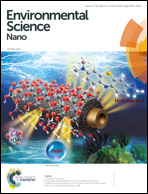Superhydrophilic phosphate and amide functionalized magnetic adsorbent: a new combination of anti-biofouling and uranium extraction from seawater†
Abstract
Phosphate and amide functionalized magnetic nanocomposites were successfully prepared via in situ synthesis for the extraction of uranium from seawater combined with an antifouling property. The magnetic hysteresis loop and contact angle tests confirm that the products possess excellent superparamagnetic and superhydrophilic properties. Interestingly, the adsorbents clearly exhibit inhibitory behavior for targeting marine algae with a more than 50% cell death rate after 7 days, due to synergistic inhibition by the superhydrophilic surface and chitosan. Subsequently, a series of adsorption experiments were performed. The nanocomposites exhibit a maximum adsorption capacity of 625 mg g−1 (pH = 8.0), and excellent selectivity for uranium sorption over coexisting ions. In addition, the adsorbents show superior regenerability and adsorption performance in simulated seawater. We suggest that the combined benefits of extraction of uranium from seawater and marine antifouling from the use of phosphate and amide functionalised magnetic adsorbents will have practical applications on an industrial scale.



 Please wait while we load your content...
Please wait while we load your content...